import torch
from fastai.vision.all import *
import cv2 as cv
import fastbook
from fastbook import *
from fastai.vision.widgets import *
import os[CAM]chest xray
Import
Data
refer : https://www.kaggle.com/paultimothymooney/chest-xray-pneumonia
# path=Path('./home/Dropbox/chest_xray/chest_xray')
path = Path(os.path.expanduser(os.path.join('~', 'Dropbox/chest_xray/chest_xray')))path.ls()(#3) [Path('/home/csy/Dropbox/chest_xray/chest_xray/train'),Path('/home/csy/Dropbox/chest_xray/chest_xray/test'),Path('/home/csy/Dropbox/chest_xray/chest_xray/val')]files=get_image_files(path)dls = ImageDataLoaders.from_folder(path, train='train', valid_pct=0.2, item_tfms=Resize(224)) dls.vocab['NORMAL', 'PNEUMONIA']dls.show_batch(max_n=16)
learn=cnn_learner(dls,resnet34,metrics=error_rate)/home/csy/anaconda3/envs/temp_csy/lib/python3.8/site-packages/fastai/vision/learner.py:288: UserWarning: `cnn_learner` has been renamed to `vision_learner` -- please update your code
warn("`cnn_learner` has been renamed to `vision_learner` -- please update your code")
/home/csy/anaconda3/envs/temp_csy/lib/python3.8/site-packages/torchvision/models/_utils.py:208: UserWarning: The parameter 'pretrained' is deprecated since 0.13 and may be removed in the future, please use 'weights' instead.
warnings.warn(
/home/csy/anaconda3/envs/temp_csy/lib/python3.8/site-packages/torchvision/models/_utils.py:223: UserWarning: Arguments other than a weight enum or `None` for 'weights' are deprecated since 0.13 and may be removed in the future. The current behavior is equivalent to passing `weights=ResNet34_Weights.IMAGENET1K_V1`. You can also use `weights=ResNet34_Weights.DEFAULT` to get the most up-to-date weights.
warnings.warn(msg)net1=learn.model[0]
net2=learn.model[1] net2 = torch.nn.Sequential(
torch.nn.AdaptiveAvgPool2d(output_size=1),
torch.nn.Flatten(),
torch.nn.Linear(512,out_features=2,bias=False))net=torch.nn.Sequential(net1,net2)lrnr2=Learner(dls,net,metrics=accuracy) lrnr2.fine_tune(200) | epoch | train_loss | valid_loss | accuracy | time |
|---|---|---|---|---|
| 0 | 0.256840 | 0.114656 | 0.955594 | 08:44 |
33.00% [66/200 8:25:10<17:05:40]
| epoch | train_loss | valid_loss | accuracy | time |
|---|---|---|---|---|
| 0 | 0.116520 | 0.101848 | 0.963279 | 09:36 |
| 1 | 0.102428 | 0.094126 | 0.967549 | 08:12 |
| 2 | 0.093699 | 0.093717 | 0.967549 | 08:54 |
| 3 | 0.086143 | 0.088825 | 0.970111 | 09:29 |
| 4 | 0.081806 | 0.083427 | 0.972673 | 07:39 |
| 5 | 0.073343 | 0.083292 | 0.970965 | 08:30 |
| 6 | 0.067238 | 0.081730 | 0.971819 | 09:19 |
| 7 | 0.060490 | 0.080178 | 0.970965 | 07:47 |
| 8 | 0.057268 | 0.082641 | 0.971819 | 07:59 |
| 9 | 0.051426 | 0.083972 | 0.970965 | 09:19 |
| 10 | 0.048123 | 0.085828 | 0.968403 | 08:25 |
| 11 | 0.048666 | 0.088471 | 0.966695 | 07:34 |
| 12 | 0.039608 | 0.081649 | 0.970965 | 09:34 |
| 13 | 0.039144 | 0.082900 | 0.969257 | 08:33 |
| 14 | 0.036003 | 0.088085 | 0.969257 | 07:21 |
| 15 | 0.033820 | 0.090371 | 0.966695 | 09:41 |
| 16 | 0.030702 | 0.090631 | 0.965841 | 08:42 |
| 17 | 0.030634 | 0.088019 | 0.968403 | 06:44 |
| 18 | 0.028083 | 0.086056 | 0.974381 | 09:44 |
| 19 | 0.026960 | 0.093619 | 0.966695 | 09:01 |
| 20 | 0.027269 | 0.101308 | 0.966695 | 06:51 |
| 21 | 0.022599 | 0.092235 | 0.967549 | 10:03 |
| 22 | 0.020182 | 0.101367 | 0.966695 | 09:07 |
| 23 | 0.018661 | 0.107479 | 0.966695 | 06:53 |
| 24 | 0.022132 | 0.090607 | 0.971819 | 09:42 |
| 25 | 0.020702 | 0.119097 | 0.965841 | 09:13 |
| 26 | 0.018335 | 0.100486 | 0.970965 | 07:02 |
| 27 | 0.023388 | 0.091187 | 0.974381 | 09:31 |
| 28 | 0.014129 | 0.109383 | 0.971819 | 09:16 |
| 29 | 0.011590 | 0.091540 | 0.973527 | 07:19 |
| 30 | 0.011195 | 0.112240 | 0.969257 | 09:14 |
| 31 | 0.010830 | 0.123103 | 0.970111 | 09:16 |
| 32 | 0.011482 | 0.111904 | 0.973527 | 07:22 |
| 33 | 0.009102 | 0.113118 | 0.973527 | 09:06 |
| 34 | 0.012337 | 0.114353 | 0.970111 | 07:51 |
| 35 | 0.012090 | 0.123892 | 0.970965 | 05:32 |
| 36 | 0.012958 | 0.130399 | 0.972673 | 05:38 |
| 37 | 0.011067 | 0.154380 | 0.965841 | 08:05 |
| 38 | 0.012189 | 0.106678 | 0.973527 | 06:58 |
| 39 | 0.013642 | 0.094777 | 0.977797 | 04:06 |
| 40 | 0.013831 | 0.136403 | 0.970111 | 08:22 |
| 41 | 0.010596 | 0.125548 | 0.974381 | 07:40 |
| 42 | 0.011968 | 0.122372 | 0.974381 | 04:49 |
| 43 | 0.010313 | 0.140959 | 0.971819 | 07:01 |
| 44 | 0.015604 | 0.116439 | 0.972673 | 07:46 |
| 45 | 0.009300 | 0.109000 | 0.975235 | 05:58 |
| 46 | 0.010223 | 0.114949 | 0.975235 | 05:03 |
| 47 | 0.010521 | 0.112844 | 0.975235 | 08:26 |
| 48 | 0.010516 | 0.120698 | 0.978651 | 07:13 |
| 49 | 0.006499 | 0.103925 | 0.980359 | 04:13 |
| 50 | 0.015288 | 0.140839 | 0.973527 | 08:11 |
| 51 | 0.009214 | 0.115853 | 0.975235 | 07:46 |
| 52 | 0.010889 | 0.124385 | 0.971819 | 05:01 |
| 53 | 0.010107 | 0.112582 | 0.978651 | 06:47 |
| 54 | 0.008590 | 0.108547 | 0.976943 | 07:51 |
| 55 | 0.012988 | 0.102842 | 0.978651 | 06:07 |
| 56 | 0.013263 | 0.112827 | 0.979505 | 04:47 |
| 57 | 0.009377 | 0.111573 | 0.977797 | 08:15 |
| 58 | 0.008087 | 0.126913 | 0.976089 | 07:22 |
| 59 | 0.006141 | 0.105021 | 0.981213 | 04:23 |
| 60 | 0.009329 | 0.121833 | 0.975235 | 07:45 |
| 61 | 0.010449 | 0.128219 | 0.978651 | 07:51 |
| 62 | 0.011542 | 0.107680 | 0.979505 | 05:15 |
| 63 | 0.009637 | 0.151910 | 0.967549 | 06:17 |
| 64 | 0.012696 | 0.154750 | 0.972673 | 08:00 |
| 65 | 0.008207 | 0.125963 | 0.978651 | 06:21 |
10.53% [2/19 00:11<01:40 0.0056]
lrnr2.fine_tune(100)
0.00% [0/1 00:00<?]
| epoch | train_loss | valid_loss | accuracy | time |
|---|
49.32% [36/73 03:03<03:08 0.0001]
interp = ClassificationInterpretation.from_learner(lrnr2)
interp.plot_confusion_matrix()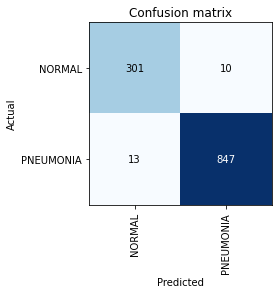
fig, ax = plt.subplots(5,5)
k=0
for i in range(5):
for j in range(5):
x, = first(dls.test_dl([PILImage.create(get_image_files(path)[k])]))
camimg = torch.einsum('ij,jkl -> ikl', net2[2].weight, net1(x).squeeze())
a,b = net(x).tolist()[0]
normalprob, pneumoniaprob = np.exp(a)/ (np.exp(a)+np.exp(b)) , np.exp(b)/ (np.exp(a)+np.exp(b))
if normalprob>pneumoniaprob:
dls.train.decode((x,))[0].squeeze().show(ax=ax[i][j])
ax[i][j].imshow(camimg[0].to("cpu").detach(),alpha=0.5,extent=(0,224,224,0),interpolation='bilinear',cmap='magma')
ax[i][j].set_title("normal(%s)" % normalprob.round(5))
else:
dls.train.decode((x,))[0].squeeze().show(ax=ax[i][j])
ax[i][j].imshow(camimg[1].to("cpu").detach(),alpha=0.5,extent=(0,224,224,0),interpolation='bilinear',cmap='magma')
ax[i][j].set_title("pneumonia(%s)" % pneumoniaprob.round(5))
k=k+1
fig.set_figwidth(16)
fig.set_figheight(16)
fig.tight_layout()
특정 이미지 select
img = PILImage.create(get_image_files(path)[304])
img
x, = first(dls.test_dl([img])) #이미지 텐서화a=net(x).tolist()[0][0]
b=net(x).tolist()[0][1]
np.exp(a)/(np.exp(a)+np.exp(b)), np.exp(b)/(np.exp(a)+np.exp(b))(1.54300621731869e-12, 0.9999999999984569)camimg = torch.einsum('ij,jkl -> ikl', net2[2].weight, net1(x).squeeze())fig, (ax1,ax2) = plt.subplots(1,2)
dls.train.decode((x,))[0].squeeze().show(ax=ax1)
ax1.imshow(camimg[0].to("cpu").detach(),alpha=0.5,extent=(0,224,224,0),interpolation='bilinear',cmap='cool')
ax1.set_title("NORMAL PART")
#
dls.train.decode((x,))[0].squeeze().show(ax=ax2)
ax2.imshow(camimg[1].to("cpu").detach(),alpha=0.5,extent=(0,224,224,0),interpolation='bilinear',cmap='cool')
ax2.set_title("DISEASE PART")
#
fig.set_figwidth(8)
fig.set_figheight(8)
fig.tight_layout()
보라색 일 수록 특징이 강함을 의미..
test=camimg[1]-torch.min(camimg[1])A1=torch.exp(-0.04*test)A2=1-A1fig, (ax1, ax2) = plt.subplots(1,2)
dls.train.decode((x,))[0].squeeze().show(ax=ax1)
ax1.imshow(A2.data.to("cpu").detach(),alpha=0.5,extent=(0,224,224,0),interpolation='bilinear',cmap='cool')
ax1.set_title("X1 WEIGHT WITH THETA=0.04")
#
dls.train.decode((x,))[0].squeeze().show(ax=ax2)
ax2.imshow(A1.data.to("cpu").detach(),alpha=0.5,extent=(0,224,224,0),interpolation='bilinear',cmap='cool')
ax2.set_title("X1 RES WEIGHT WITH THETA=0.04")
#
fig.set_figwidth(8)
fig.set_figheight(8)
fig.tight_layout()
#mode1_res*x
X1=np.array(A1.to("cpu").detach(),dtype=np.float32)
Y1=torch.Tensor(cv.resize(X1,(224,224),interpolation=cv.INTER_LINEAR))
x1=(x.squeeze().to('cpu')*Y1-torch.min(x.squeeze().to('cpu')*0.7*Y1))*0.4#mode1*x
X12=np.array(A2.to("cpu").detach(),dtype=np.float32)
Y12=torch.Tensor(cv.resize(X1,(224,224),interpolation=cv.INTER_LINEAR))
x12=x.squeeze().to('cpu')*Y12*31st cam 결과 분리
fig, (ax1) = plt.subplots(1,1)
dls.train.decode((x,))[0].squeeze().show(ax=ax1)
ax1.set_title("ORIGINAL")
fig.set_figwidth(4)
fig.set_figheight(4)
fig.tight_layout()
#
fig, (ax1, ax2) = plt.subplots(1,2)
x12.squeeze().show(ax=ax1) #MODE1
x1.squeeze().show(ax=ax2) #MODE1_res
ax1.set_title("X1")
ax2.set_title("X1 RES")
fig.set_figwidth(8)
fig.set_figheight(8)
fig.tight_layout()Clipping input data to the valid range for imshow with RGB data ([0..1] for floats or [0..255] for integers).
Clipping input data to the valid range for imshow with RGB data ([0..1] for floats or [0..255] for integers).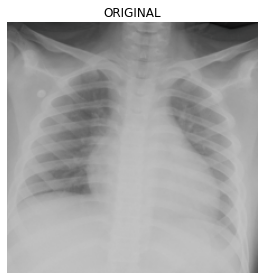
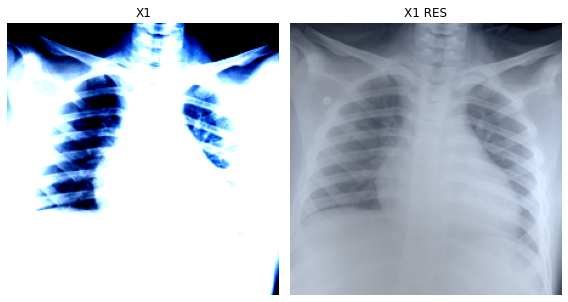
x1=x1.reshape(1,3,224,224)net1.to('cpu')
net2.to('cpu')Sequential(
(0): AdaptiveAvgPool2d(output_size=1)
(1): Flatten(start_dim=1, end_dim=-1)
(2): Linear(in_features=512, out_features=2, bias=False)
)ver2 = torch.einsum('ij,jkl -> ikl', net2[2].weight, net1(x1).squeeze())fig, (ax1,ax2) = plt.subplots(1,2)
#
x1.squeeze().show(ax=ax1)
ax1.imshow(ver2[0].to("cpu").detach(),alpha=0.5,extent=(0,223,223,0),interpolation='bilinear',cmap='cool')
ax1.set_title("NORMAL PART")
#
x1.squeeze().show(ax=ax2)
ax2.imshow(ver2[1].to("cpu").detach(),alpha=0.5,extent=(0,223,223,0),interpolation='bilinear',cmap='cool')
ax2.set_title("DISEASE PART")
fig.set_figwidth(8)
fig.set_figheight(8)
fig.tight_layout()Clipping input data to the valid range for imshow with RGB data ([0..1] for floats or [0..255] for integers).
Clipping input data to the valid range for imshow with RGB data ([0..1] for floats or [0..255] for integers).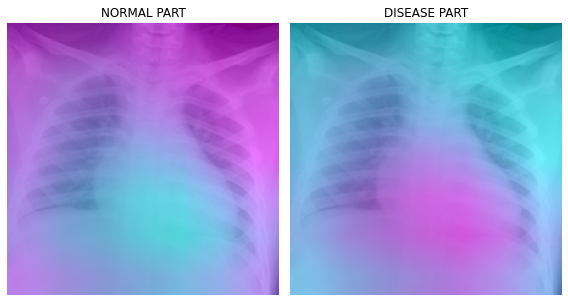
fig, (ax1,ax2) = plt.subplots(1,2)
#
dls.train.decode((x,))[0].squeeze().show(ax=ax1)
ax1.imshow(camimg[1].to("cpu").detach(),alpha=0.5,extent=(0,223,223,0),interpolation='bilinear',cmap='cool')
ax1.set_title("1ST CAM")
#
dls.train.decode((x,))[0].squeeze().show(ax=ax2)
ax2.imshow(ver2[1].to("cpu").detach(),alpha=0.5,extent=(0,223,223,0),interpolation='bilinear',cmap='cool')
ax2.set_title("2ND CAM")
fig.set_figwidth(8)
fig.set_figheight(8)
fig.tight_layout()
a1=net(x1).tolist()[0][0]
b1=net(x1).tolist()[0][1]
np.exp(a1)/(np.exp(a1)+np.exp(b1)), np.exp(b1)/(np.exp(a1)+np.exp(b1))(6.664552246309979e-19, 1.0)\(\theta\) 생각, hyperparameter로서..
test1=ver2[0]-torch.min(ver2[0])A3=torch.exp(-0.04*test1) A4=1-A3fig, (ax1, ax2) = plt.subplots(1,2)
dls.train.decode((x,))[0].squeeze().show(ax=ax1)
ax1.imshow(A3.data.to("cpu").detach(),alpha=0.5,extent=(0,224,224,0),interpolation='bilinear',cmap='cool')
ax1.set_title("MODE2 WEIGHT WITH THETA=0.04")
#
dls.train.decode((x,))[0].squeeze().show(ax=ax2)
ax2.imshow(A4.data.to("cpu").detach(),alpha=0.5,extent=(0,224,224,0),interpolation='bilinear',cmap='cool')
ax2.set_title("MODE2 RES WEIGHT WITH THETA=0.04")
#
fig.set_figwidth(8)
fig.set_figheight(8)
fig.tight_layout()
#mode2_res
X3=np.array(A3.to("cpu").detach(),dtype=np.float32)
Y3=torch.Tensor(cv.resize(X3,(224,224),interpolation=cv.INTER_LINEAR))
x3=x.squeeze().to('cpu')*Y1*Y3-torch.min(x.squeeze().to('cpu')*Y1*Y3)#mode1*x
X4=np.array(A4.to("cpu").detach(),dtype=np.float32)
Y4=torch.Tensor(cv.resize(X4,(224,224),interpolation=cv.INTER_LINEAR))
x4=x.squeeze().to('cpu')*Y1*Y42nd 분리 결과
fig, (ax1) = plt.subplots(1,1)
dls.train.decode((x,))[0].squeeze().show(ax=ax1)
ax1.set_title("ORIGINAL")
fig.set_figwidth(4)
fig.set_figheight(4)
fig.tight_layout()
#
fig, (ax1, ax2) = plt.subplots(1,2)
x12.squeeze().show(ax=ax1)
x1.squeeze().show(ax=ax2)
ax1.set_title("MODE1")
ax2.set_title("MODE1 RES")
fig.set_figwidth(8)
fig.set_figheight(8)
fig.tight_layout()
#
fig, (ax1, ax2) = plt.subplots(1,2)
x4.squeeze().show(ax=ax1)
x3.squeeze().show(ax=ax2)
ax1.set_title("MODE2")
ax2.set_title("MODE2 RES")
fig.set_figwidth(8)
fig.set_figheight(8)
fig.tight_layout()Clipping input data to the valid range for imshow with RGB data ([0..1] for floats or [0..255] for integers).
Clipping input data to the valid range for imshow with RGB data ([0..1] for floats or [0..255] for integers).
Clipping input data to the valid range for imshow with RGB data ([0..1] for floats or [0..255] for integers).
Clipping input data to the valid range for imshow with RGB data ([0..1] for floats or [0..255] for integers).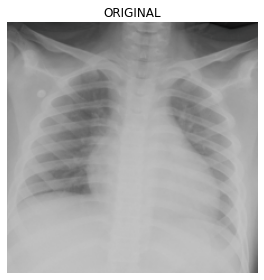
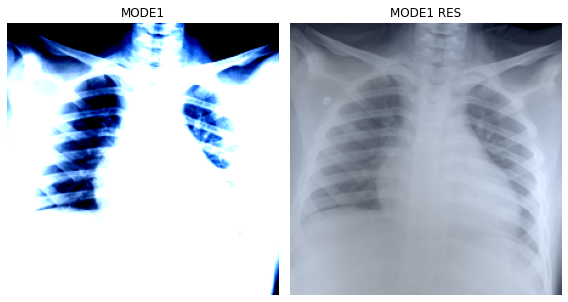
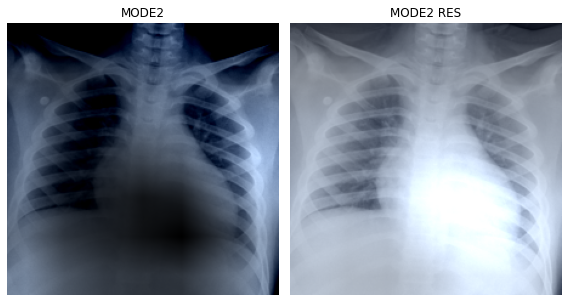
x3=x3.reshape(1,3,224,224)net1.to('cpu')
net2.to('cpu')Sequential(
(0): AdaptiveAvgPool2d(output_size=1)
(1): Flatten(start_dim=1, end_dim=-1)
(2): Linear(in_features=512, out_features=2, bias=False)
)ver22 = torch.einsum('ij,jkl -> ikl', net2[2].weight, net1(x3).squeeze())CAM
fig, (ax1,ax2) = plt.subplots(1,2)
#
x3.squeeze().show(ax=ax1)
ax1.imshow(ver22[0].to("cpu").detach(),alpha=0.5,extent=(0,223,223,0),interpolation='bilinear',cmap='cool')
ax1.set_title("NORMAL PART")
#
x3.squeeze().show(ax=ax2)
ax2.imshow(ver22[1].to("cpu").detach(),alpha=0.5,extent=(0,223,223,0),interpolation='bilinear',cmap='cool')
ax2.set_title("DISEASE PART")
fig.set_figwidth(8)
fig.set_figheight(8)
fig.tight_layout()Clipping input data to the valid range for imshow with RGB data ([0..1] for floats or [0..255] for integers).
Clipping input data to the valid range for imshow with RGB data ([0..1] for floats or [0..255] for integers).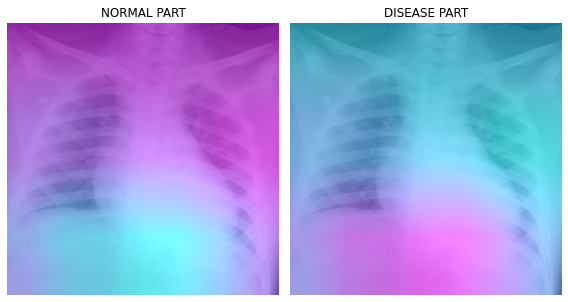
fig, (ax1,ax2, ax3) = plt.subplots(1,3)
#
dls.train.decode((x,))[0].squeeze().show(ax=ax1)
ax1.imshow(camimg[1].to("cpu").detach(),alpha=0.5,extent=(0,223,223,0),interpolation='bilinear',cmap='cool')
ax1.set_title("1ST CAM")
#
dls.train.decode((x,))[0].squeeze().show(ax=ax2)
ax2.imshow(ver2[1].to("cpu").detach(),alpha=0.5,extent=(0,223,223,0),interpolation='bilinear',cmap='cool')
ax2.set_title("2ND CAM")
#
dls.train.decode((x,))[0].squeeze().show(ax=ax3)
ax3.imshow(ver22[1].to("cpu").detach(),alpha=0.5,extent=(0,223,223,0),interpolation='bilinear',cmap='cool')
ax3.set_title("3RD CAM")
#
fig.set_figwidth(12)
fig.set_figheight(12)
fig.tight_layout()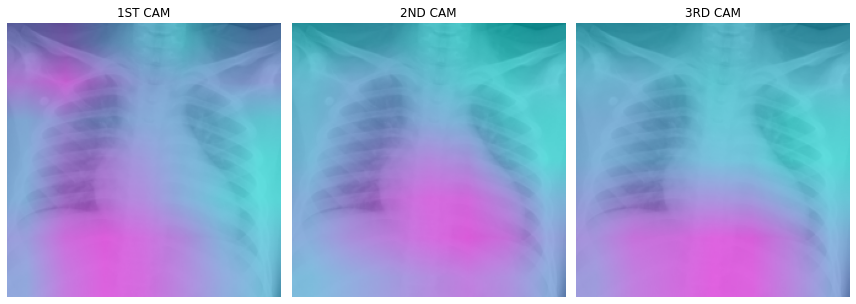
a2=net(x3).tolist()[0][0]
b2=net(x3).tolist()[0][1]
np.exp(a2)/(np.exp(a2)+np.exp(b2)), np.exp(b2)/(np.exp(a2)+np.exp(b2))(3.322455317236289e-16, 0.9999999999999998)another 특정 그림 select
img = PILImage.create(get_image_files(path)[3031])
img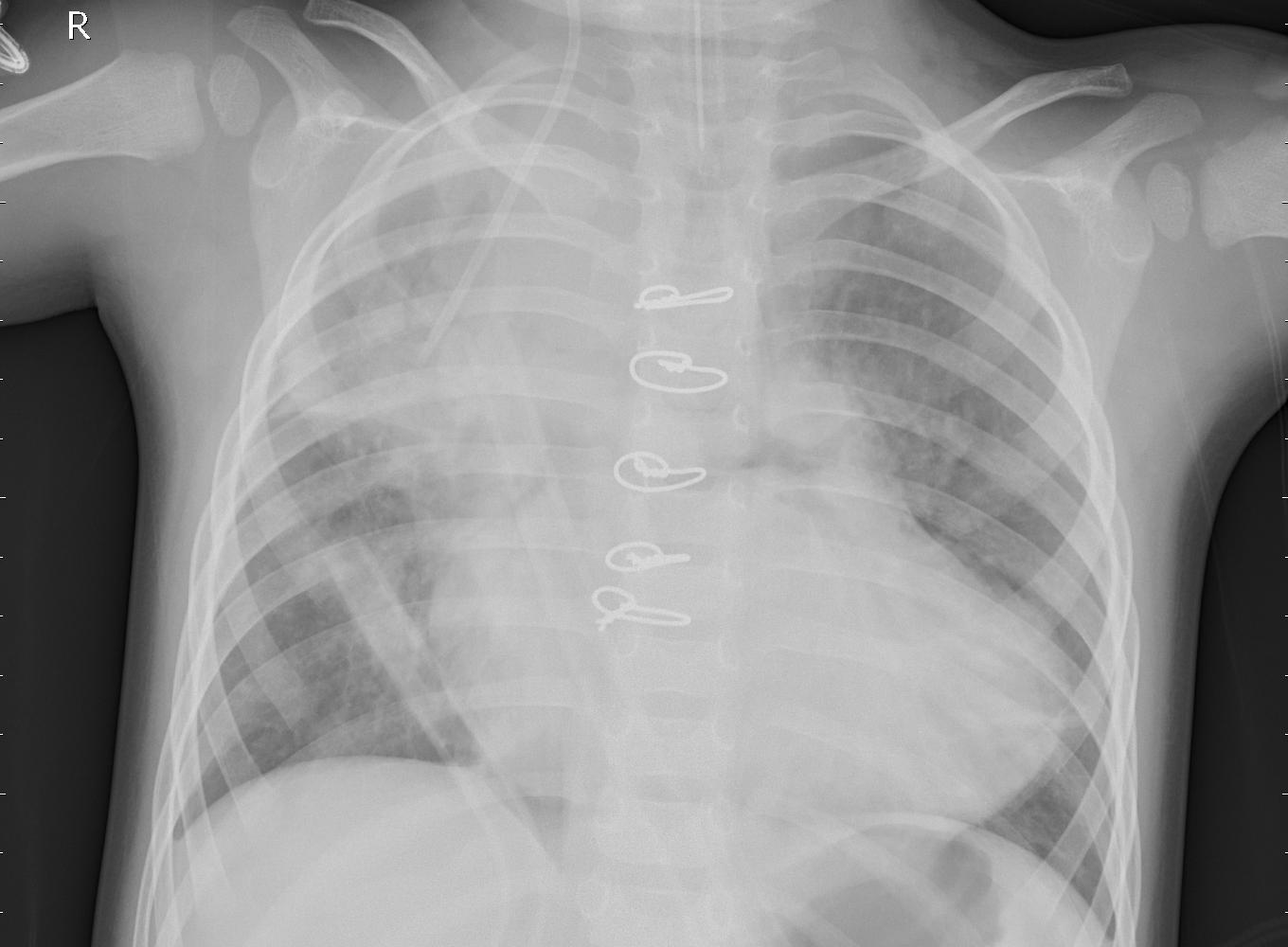
철심
x, = first(dls.test_dl([img])) #이미지 텐서화x=x.to('cpu')a=net(x).tolist()[0][0]
b=net(x).tolist()[0][1]
np.exp(a)/(np.exp(a)+np.exp(b)), np.exp(b)/(np.exp(a)+np.exp(b))(2.994815878500848e-17, 1.0)camimg = torch.einsum('ij,jkl -> ikl', net2[2].weight, net1(x).squeeze())fig, (ax1,ax2) = plt.subplots(1,2)
dls.train.decode((x,))[0].squeeze().show(ax=ax1)
ax1.imshow(camimg[0].to("cpu").detach(),alpha=0.5,extent=(0,224,224,0),interpolation='bilinear',cmap='cool')
ax1.set_title("NORMAL PART")
#
dls.train.decode((x,))[0].squeeze().show(ax=ax2)
ax2.imshow(camimg[1].to("cpu").detach(),alpha=0.5,extent=(0,224,224,0),interpolation='bilinear',cmap='cool')
ax2.set_title("DISEASE PART")
#
fig.set_figwidth(8)
fig.set_figheight(8)
fig.tight_layout()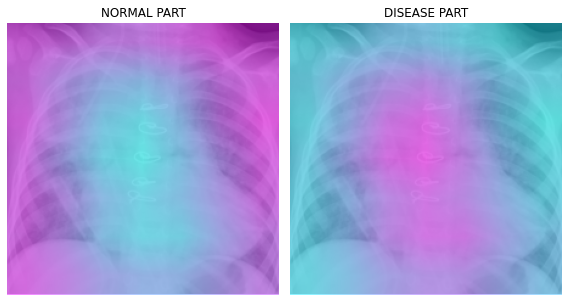
철심 있는 부분 디텍팅
test=camimg[0]-torch.min(camimg[0])test1=camimg[1]-torch.min(camimg[1])A1=torch.exp(-0.05*test)A2=1-A1A11=torch.exp(-0.05*test1)fig, (ax1, ax2) = plt.subplots(1,2)
dls.train.decode((x,))[0].squeeze().show(ax=ax1)
ax1.imshow(A2.data.to("cpu").detach(),alpha=0.5,extent=(0,224,224,0),interpolation='bilinear',cmap='cool')
ax1.set_title("X1 WEIGHT WITH THETA=0.05")
#
dls.train.decode((x,))[0].squeeze().show(ax=ax2)
ax2.imshow(A11.data.to("cpu").detach(),alpha=0.5,extent=(0,224,224,0),interpolation='bilinear',cmap='cool')
ax2.set_title("X1 RES WEIGHT WITH THETA=0.05")
#
fig.set_figwidth(8)
fig.set_figheight(8)
fig.tight_layout()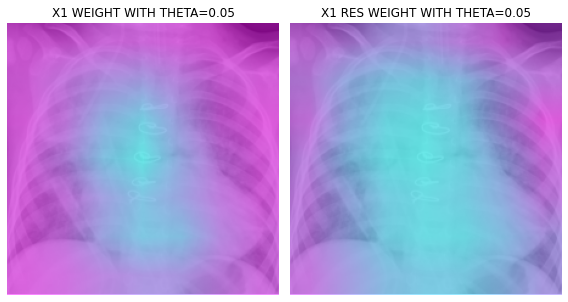
#mode1_res*x
X1=np.array(A11.to("cpu").detach(),dtype=np.float32)
Y1=torch.Tensor(cv.resize(X1,(224,224),interpolation=cv.INTER_LINEAR))
#x1=(x.squeeze().to('cpu')*Y1-torch.min(x.squeeze().to('cpu')*0.7*Y1))*0.4
x1=(x.squeeze().to('cpu')*Y1-torch.min(x.squeeze().to('cpu')*Y1))*0.18#mode1그림을 위한 mode1_res*x
X_1=np.array(A1.to("cpu").detach(),dtype=np.float32)
Y_1=torch.Tensor(cv.resize(X1,(224,224),interpolation=cv.INTER_LINEAR))
#x1=(x.squeeze().to('cpu')*Y1-torch.min(x.squeeze().to('cpu')*0.7*Y1))*0.4
x_1=x.squeeze().to('cpu')*Y1-torch.min(x.squeeze().to('cpu')*Y1)*0.05#mode1*x
X12=np.array(A2.to("cpu").detach(),dtype=np.float32)
Y12=torch.Tensor(cv.resize(X_1,(224,224),interpolation=cv.INTER_LINEAR))
x12=x.squeeze().to('cpu')*Y12*0.31st cam 결과
fig, (ax1) = plt.subplots(1,1)
dls.train.decode((x,))[0].squeeze().show(ax=ax1)
ax1.set_title("ORIGINAL")
fig.set_figwidth(4)
fig.set_figheight(4)
fig.tight_layout()
#
fig, (ax1, ax2) = plt.subplots(1,2)
x12.squeeze().show(ax=ax1) #MODE1
x1.squeeze().show(ax=ax2) #MODE1_res
ax1.set_title("X1")
ax2.set_title("X1 RES")
fig.set_figwidth(8)
fig.set_figheight(8)
fig.tight_layout()Clipping input data to the valid range for imshow with RGB data ([0..1] for floats or [0..255] for integers).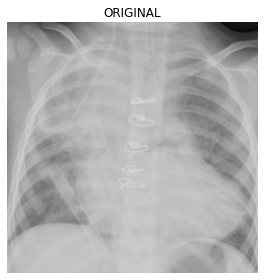
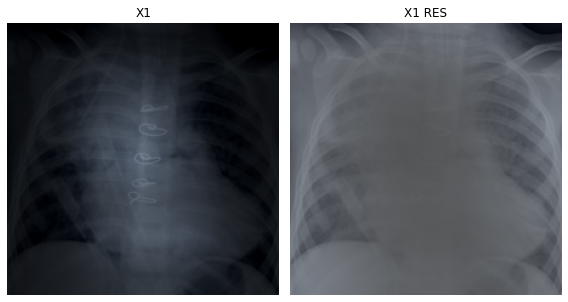
x1=x1.reshape(1,3,224,224)net1.to('cpu')
net2.to('cpu')Sequential(
(0): AdaptiveAvgPool2d(output_size=1)
(1): Flatten(start_dim=1, end_dim=-1)
(2): Linear(in_features=512, out_features=2, bias=False)
)2차
ver2 = torch.einsum('ij,jkl -> ikl', net2[2].weight, net1(x1).squeeze())CAM
fig, (ax1,ax2) = plt.subplots(1,2)
#
x1.squeeze().show(ax=ax1)
ax1.imshow(ver2[0].to("cpu").detach(),alpha=0.5,extent=(0,223,223,0),interpolation='bilinear',cmap='cool')
ax1.set_title("NORMAL PART")
#
x1.squeeze().show(ax=ax2)
ax2.imshow(ver2[1].to("cpu").detach(),alpha=0.5,extent=(0,223,223,0),interpolation='bilinear',cmap='cool')
ax2.set_title("DISEASE PART")
fig.set_figwidth(8)
fig.set_figheight(8)
fig.tight_layout()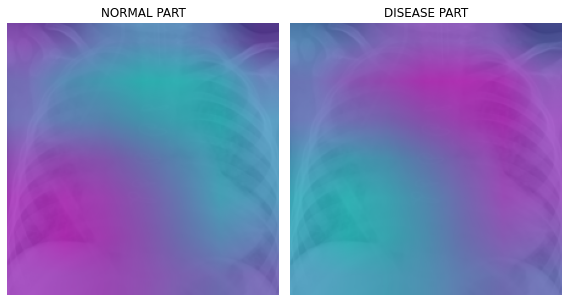
fig, (ax1,ax2) = plt.subplots(1,2)
#
dls.train.decode((x,))[0].squeeze().show(ax=ax1)
ax1.imshow(camimg[1].to("cpu").detach(),alpha=0.5,extent=(0,223,223,0),interpolation='bilinear',cmap='cool')
ax1.set_title("1ST CAM")
#
dls.train.decode((x,))[0].squeeze().show(ax=ax2)
ax2.imshow(ver2[1].to("cpu").detach(),alpha=0.5,extent=(0,223,223,0),interpolation='bilinear',cmap='cool')
ax2.set_title("2ND CAM")
fig.set_figwidth(8)
fig.set_figheight(8)
fig.tight_layout()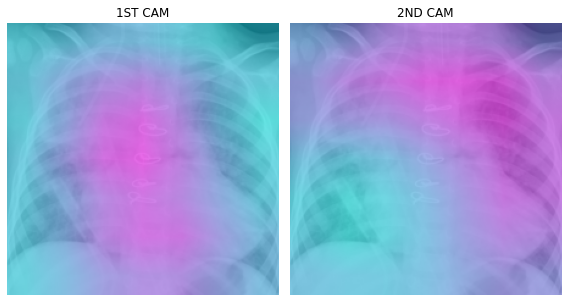
a1=net(x1).tolist()[0][0]
b1=net(x1).tolist()[0][1]
np.exp(a1)/(np.exp(a1)+np.exp(b1)), np.exp(b1)/(np.exp(a1)+np.exp(b1))(3.013152213595138e-16, 0.9999999999999997)test=ver2[0]-torch.min(ver2[0])test1=ver2[1]-torch.min(ver2[1])A3=torch.exp(-0.08*test) A4=1-A3A33 = torch.exp(-0.08*test1)fig, (ax1, ax2) = plt.subplots(1,2)
dls.train.decode((x,))[0].squeeze().show(ax=ax1)
ax1.imshow(A4.data.to("cpu").detach(),alpha=0.5,extent=(0,224,224,0),interpolation='bilinear',cmap='cool')
ax1.set_title("X2 WEIGHT WITH THETA=0.08")
#
dls.train.decode((x,))[0].squeeze().show(ax=ax2)
ax2.imshow(A33.data.to("cpu").detach(),alpha=0.5,extent=(0,224,224,0),interpolation='bilinear',cmap='cool')
ax2.set_title("X2 RES WEIGHT WITH THETA=0.08")
#
fig.set_figwidth(8)
fig.set_figheight(8)
fig.tight_layout()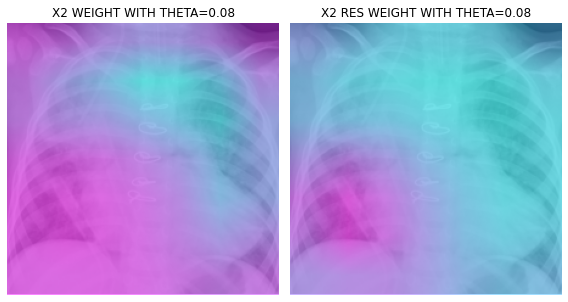
#mode2_res
X3=np.array(A33.to("cpu").detach(),dtype=np.float32)
Y3=torch.Tensor(cv.resize(X3,(224,224),interpolation=cv.INTER_LINEAR))
x3=(x.squeeze().to('cpu')*Y1-torch.min(x.squeeze().to('cpu')*Y1))*0.2*Y3
#x1=x.squeeze().to('cpu')*Y1-torch.min(x.squeeze().to('cpu')*Y1)*0.03#mode1그림을 위한 mode2_res*x
X_3=np.array(A3.to("cpu").detach(),dtype=np.float32)
Y_3=torch.Tensor(cv.resize(X_3,(224,224),interpolation=cv.INTER_LINEAR))
x_3=(x.squeeze().to('cpu')*Y1-torch.min(x.squeeze().to('cpu')*Y1))*Y3#mode2*x
X4=np.array(A4.to("cpu").detach(),dtype=np.float32)
Y4=torch.Tensor(cv.resize(X_3,(224,224),interpolation=cv.INTER_LINEAR))
x4=(x.squeeze().to('cpu')*Y1-torch.min(x.squeeze().to('cpu')*Y1))*Y4*0.22nd cam 결과 분리
fig, (ax1) = plt.subplots(1,1)
dls.train.decode((x,))[0].squeeze().show(ax=ax1)
ax1.set_title("ORIGINAL")
fig.set_figwidth(4)
fig.set_figheight(4)
fig.tight_layout()
#
fig, (ax1, ax2) = plt.subplots(1,2)
x12.squeeze().show(ax=ax1)
x1.squeeze().show(ax=ax2)
ax1.set_title("MODE1")
ax2.set_title("MODE1 RES")
fig.set_figwidth(8)
fig.set_figheight(8)
fig.tight_layout()
#
fig, (ax1, ax2) = plt.subplots(1,2)
x4.squeeze().show(ax=ax1)
x3.squeeze().show(ax=ax2)
ax1.set_title("X2")
ax2.set_title("X2 RES")
fig.set_figwidth(8)
fig.set_figheight(8)
fig.tight_layout()Clipping input data to the valid range for imshow with RGB data ([0..1] for floats or [0..255] for integers).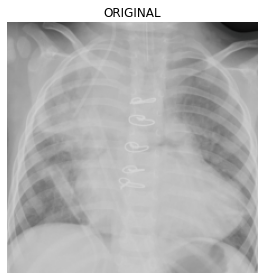
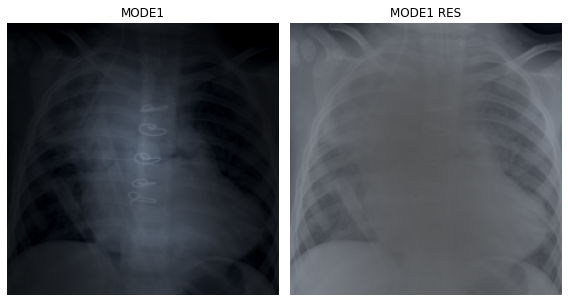
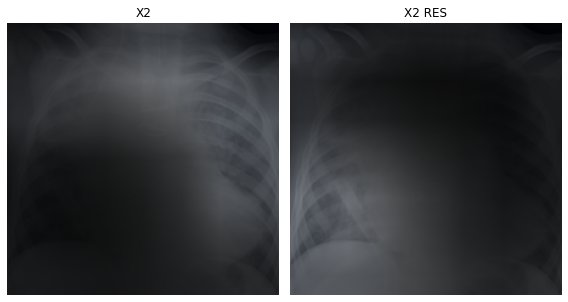
x3=x3.reshape(1,3,224,224)net1.to('cpu')
net2.to('cpu')Sequential(
(0): AdaptiveAvgPool2d(output_size=1)
(1): Flatten(start_dim=1, end_dim=-1)
(2): Linear(in_features=512, out_features=2, bias=False)
)ver22 = torch.einsum('ij,jkl -> ikl', net2[2].weight, net1(x3).squeeze())CAM
fig, (ax1,ax2) = plt.subplots(1,2)
#
x3.squeeze().show(ax=ax1)
ax1.imshow(ver22[0].to("cpu").detach(),alpha=0.5,extent=(0,223,223,0),interpolation='bilinear',cmap='cool')
ax1.set_title("NORMAL PART")
#
x3.squeeze().show(ax=ax2)
ax2.imshow(ver22[1].to("cpu").detach(),alpha=0.5,extent=(0,223,223,0),interpolation='bilinear',cmap='cool')
ax2.set_title("DISEASE PART")
fig.set_figwidth(8)
fig.set_figheight(8)
fig.tight_layout()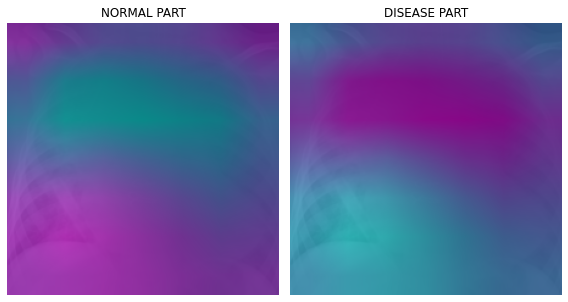
fig, (ax1,ax2, ax3) = plt.subplots(1,3)
#
dls.train.decode((x,))[0].squeeze().show(ax=ax1)
ax1.imshow(camimg[1].to("cpu").detach(),alpha=0.5,extent=(0,223,223,0),interpolation='bilinear',cmap='cool')
ax1.set_title("1ST CAM")
#
dls.train.decode((x,))[0].squeeze().show(ax=ax2)
ax2.imshow(ver2[1].to("cpu").detach(),alpha=0.5,extent=(0,223,223,0),interpolation='bilinear',cmap='cool')
ax2.set_title("2ND CAM")
#
dls.train.decode((x,))[0].squeeze().show(ax=ax3)
ax3.imshow(ver22[1].to("cpu").detach(),alpha=0.5,extent=(0,223,223,0),interpolation='bilinear',cmap='cool')
ax3.set_title("3RD CAM")
#
fig.set_figwidth(12)
fig.set_figheight(12)
fig.tight_layout()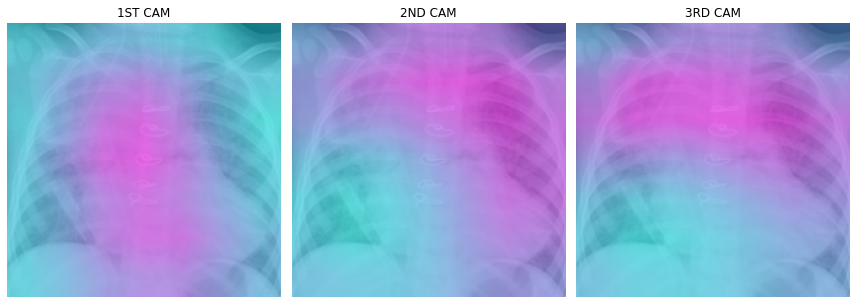
a2=net(x3).tolist()[0][0]
b2=net(x3).tolist()[0][1]
np.exp(a2)/(np.exp(a2)+np.exp(b2)), np.exp(b2)/(np.exp(a2)+np.exp(b2))(1.1537635027871649e-15, 0.9999999999999989)other 다른 그림
img = PILImage.create(get_image_files(path)[3107])
img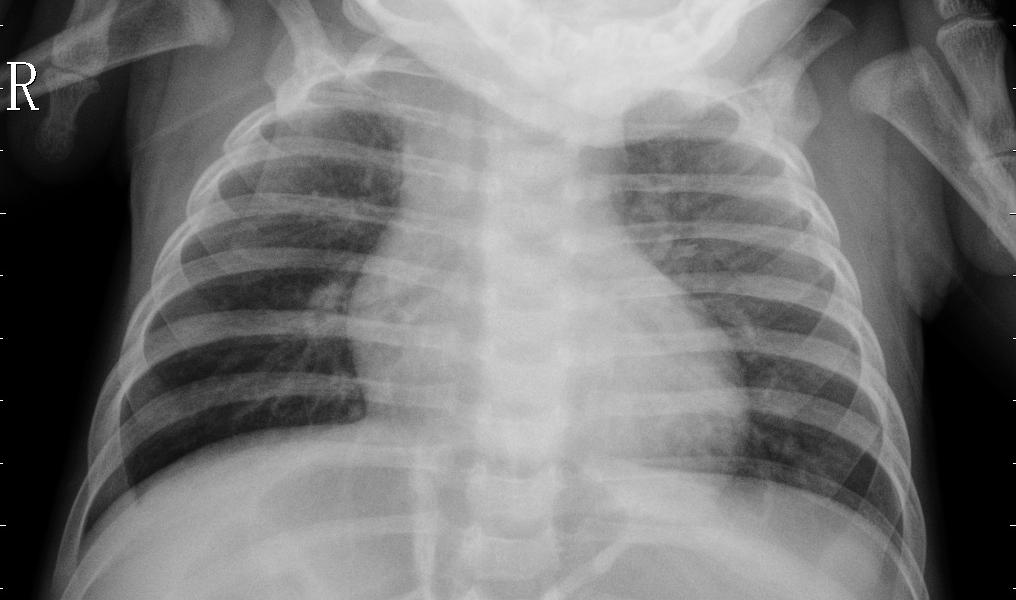
x, = first(dls.test_dl([img])) #이미지 텐서화x=x.to('cpu')a=net(x).tolist()[0][0]
b=net(x).tolist()[0][1]
np.exp(a)/(np.exp(a)+np.exp(b)), np.exp(b)/(np.exp(a)+np.exp(b))(6.990148118894787e-19, 1.0)camimg = torch.einsum('ij,jkl -> ikl', net2[2].weight, net1(x).squeeze())fig, (ax1,ax2) = plt.subplots(1,2)
dls.train.decode((x,))[0].squeeze().show(ax=ax1)
ax1.imshow(camimg[0].to("cpu").detach(),alpha=0.5,extent=(0,224,224,0),interpolation='bilinear',cmap='cool')
ax1.set_title("NORMAL PART")
#
dls.train.decode((x,))[0].squeeze().show(ax=ax2)
ax2.imshow(camimg[1].to("cpu").detach(),alpha=0.5,extent=(0,224,224,0),interpolation='bilinear',cmap='cool')
ax2.set_title("DISEASE PART")
#
fig.set_figwidth(8)
fig.set_figheight(8)
fig.tight_layout()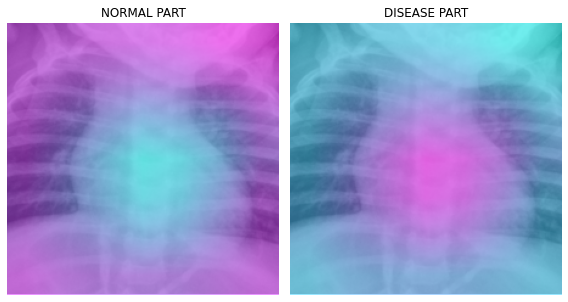
test=camimg[0]-torch.min(camimg[0])test1=camimg[1]-torch.min(camimg[1])A1=torch.exp(-0.05*test)A2=1-A1A11=torch.exp(-0.05*test1)fig, (ax1, ax2) = plt.subplots(1,2)
dls.train.decode((x,))[0].squeeze().show(ax=ax1)
ax1.imshow(A2.data.to("cpu").detach(),alpha=0.5,extent=(0,224,224,0),interpolation='bilinear',cmap='cool')
ax1.set_title("X1 WEIGHT WITH THETA=0.05")
#
dls.train.decode((x,))[0].squeeze().show(ax=ax2)
ax2.imshow(A11.data.to("cpu").detach(),alpha=0.5,extent=(0,224,224,0),interpolation='bilinear',cmap='cool')
ax2.set_title("X1 RES WEIGHT WITH THETA=0.05")
#
fig.set_figwidth(8)
fig.set_figheight(8)
fig.tight_layout()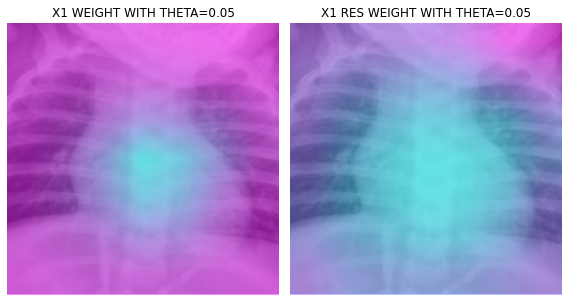
#mode1_res*x
X1=np.array(A11.to("cpu").detach(),dtype=np.float32)
Y1=torch.Tensor(cv.resize(X1,(224,224),interpolation=cv.INTER_LINEAR))
#x1=(x.squeeze().to('cpu')*Y1-torch.min(x.squeeze().to('cpu')*0.7*Y1))*0.4
x1=x.squeeze().to('cpu')*Y1-torch.min(x.squeeze().to('cpu')*Y1)*0.02#mode1그림을 위한 mode1_res*x
X_1=np.array(A1.to("cpu").detach(),dtype=np.float32)
Y_1=torch.Tensor(cv.resize(X1,(224,224),interpolation=cv.INTER_LINEAR))
#x1=(x.squeeze().to('cpu')*Y1-torch.min(x.squeeze().to('cpu')*0.7*Y1))*0.4
x_1=x.squeeze().to('cpu')*Y1-torch.min(x.squeeze().to('cpu')*Y1)*0.05#mode1*x
X12=np.array(A2.to("cpu").detach(),dtype=np.float32)
Y12=torch.Tensor(cv.resize(X_1,(224,224),interpolation=cv.INTER_LINEAR))
x12=x.squeeze().to('cpu')*Y12*0.31st cam 결과 분리
fig, (ax1) = plt.subplots(1,1)
dls.train.decode((x,))[0].squeeze().show(ax=ax1)
ax1.set_title("ORIGINAL")
fig.set_figwidth(4)
fig.set_figheight(4)
fig.tight_layout()
#
fig, (ax1, ax2) = plt.subplots(1,2)
x12.squeeze().show(ax=ax1) #MODE1
x1.squeeze().show(ax=ax2) #MODE1_res
ax1.set_title("X1")
ax2.set_title("X1 RES")
fig.set_figwidth(8)
fig.set_figheight(8)
fig.tight_layout()Clipping input data to the valid range for imshow with RGB data ([0..1] for floats or [0..255] for integers).
Clipping input data to the valid range for imshow with RGB data ([0..1] for floats or [0..255] for integers).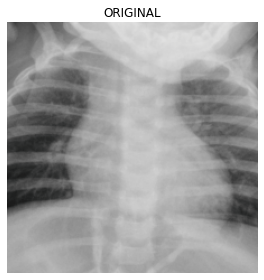
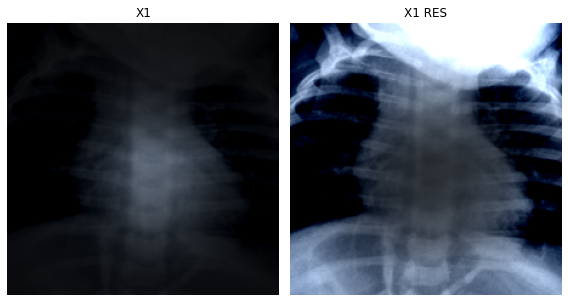
x1=x1.reshape(1,3,224,224)net1.to('cpu')
net2.to('cpu')Sequential(
(0): AdaptiveAvgPool2d(output_size=1)
(1): Flatten(start_dim=1, end_dim=-1)
(2): Linear(in_features=512, out_features=2, bias=False)
)2nd cam 분리
ver2 = torch.einsum('ij,jkl -> ikl', net2[2].weight, net1(x1).squeeze())cam
fig, (ax1,ax2) = plt.subplots(1,2)
#
x1.squeeze().show(ax=ax1)
ax1.imshow(ver2[0].to("cpu").detach(),alpha=0.5,extent=(0,223,223,0),interpolation='bilinear',cmap='cool')
ax1.set_title("NORMAL PART")
#
x1.squeeze().show(ax=ax2)
ax2.imshow(ver2[1].to("cpu").detach(),alpha=0.5,extent=(0,223,223,0),interpolation='bilinear',cmap='cool')
ax2.set_title("DISEASE PART")
fig.set_figwidth(8)
fig.set_figheight(8)
fig.tight_layout()Clipping input data to the valid range for imshow with RGB data ([0..1] for floats or [0..255] for integers).
Clipping input data to the valid range for imshow with RGB data ([0..1] for floats or [0..255] for integers).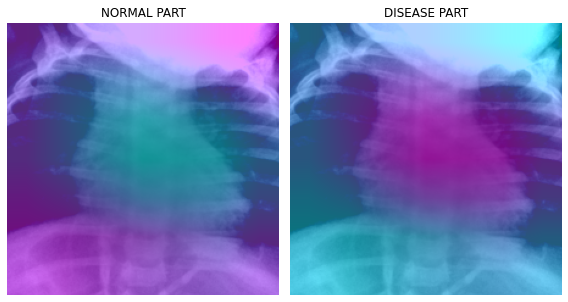
fig, (ax1,ax2) = plt.subplots(1,2)
#
dls.train.decode((x,))[0].squeeze().show(ax=ax1)
ax1.imshow(camimg[1].to("cpu").detach(),alpha=0.5,extent=(0,223,223,0),interpolation='bilinear',cmap='cool')
ax1.set_title("1ST CAM")
#
dls.train.decode((x,))[0].squeeze().show(ax=ax2)
ax2.imshow(ver2[1].to("cpu").detach(),alpha=0.5,extent=(0,223,223,0),interpolation='bilinear',cmap='cool')
ax2.set_title("2ND CAM")
fig.set_figwidth(8)
fig.set_figheight(8)
fig.tight_layout()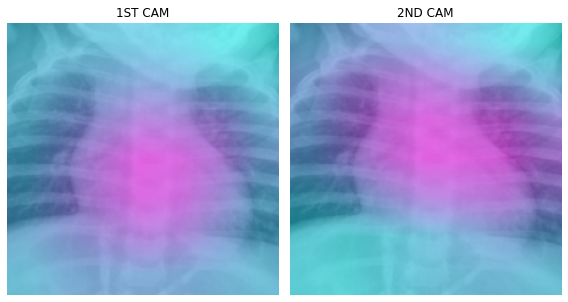
a1=net(x1).tolist()[0][0]
b1=net(x1).tolist()[0][1]
np.exp(a1)/(np.exp(a1)+np.exp(b1)), np.exp(b1)/(np.exp(a1)+np.exp(b1))(1.4950733419675e-20, 1.0)test=ver2[0]-torch.min(ver2[0])test1=ver2[1]-torch.min(ver2[1])A3=torch.exp(-0.1*test) A4=1-A3A33 = torch.exp(-0.1*test1)fig, (ax1, ax2) = plt.subplots(1,2)
dls.train.decode((x,))[0].squeeze().show(ax=ax1)
ax1.imshow(A4.data.to("cpu").detach(),alpha=0.5,extent=(0,224,224,0),interpolation='bilinear',cmap='cool')
ax1.set_title("X2 WEIGHT WITH THETA=0.1")
#
dls.train.decode((x,))[0].squeeze().show(ax=ax2)
ax2.imshow(A33.data.to("cpu").detach(),alpha=0.5,extent=(0,224,224,0),interpolation='bilinear',cmap='cool')
ax2.set_title("X2 RES WEIGHT WITH THETA=0.1")
#
fig.set_figwidth(8)
fig.set_figheight(8)
fig.tight_layout()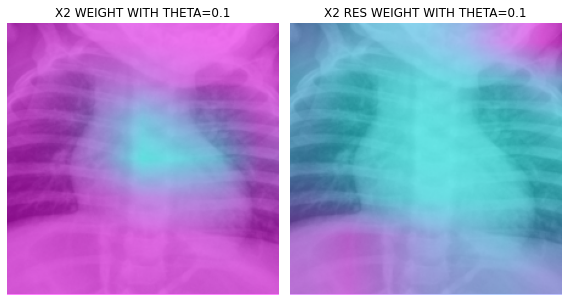
#mode2_res
X3=np.array(A33.to("cpu").detach(),dtype=np.float32)
Y3=torch.Tensor(cv.resize(X3,(224,224),interpolation=cv.INTER_LINEAR))
x3=(x.squeeze().to('cpu')*Y1-torch.min(x.squeeze().to('cpu')*Y1))*0.3*Y3
#x1=x.squeeze().to('cpu')*Y1-torch.min(x.squeeze().to('cpu')*Y1)*0.03#mode1그림을 위한 mode2_res*x
X_3=np.array(A3.to("cpu").detach(),dtype=np.float32)
Y_3=torch.Tensor(cv.resize(X_3,(224,224),interpolation=cv.INTER_LINEAR))
x_3=(x.squeeze().to('cpu')*Y1-torch.min(x.squeeze().to('cpu')*Y1))*Y3#mode2*x
X4=np.array(A4.to("cpu").detach(),dtype=np.float32)
Y4=torch.Tensor(cv.resize(X_3,(224,224),interpolation=cv.INTER_LINEAR))
x4=x.squeeze().to('cpu')*Y1-torch.min(x.squeeze().to('cpu')*Y1)*Y4*0.052nd cam 결과 분리
fig, (ax1) = plt.subplots(1,1)
dls.train.decode((x,))[0].squeeze().show(ax=ax1)
ax1.set_title("ORIGINAL")
fig.set_figwidth(4)
fig.set_figheight(4)
fig.tight_layout()
#
fig, (ax1, ax2) = plt.subplots(1,2)
x12.squeeze().show(ax=ax1)
x1.squeeze().show(ax=ax2)
ax1.set_title("MODE1")
ax2.set_title("MODE1 RES")
fig.set_figwidth(8)
fig.set_figheight(8)
fig.tight_layout()
#
fig, (ax1, ax2) = plt.subplots(1,2)
x4.squeeze().show(ax=ax1)
x3.squeeze().show(ax=ax2)
ax1.set_title("MODE2")
ax2.set_title("MODE2 RES")
fig.set_figwidth(8)
fig.set_figheight(8)
fig.tight_layout()Clipping input data to the valid range for imshow with RGB data ([0..1] for floats or [0..255] for integers).
Clipping input data to the valid range for imshow with RGB data ([0..1] for floats or [0..255] for integers).
Clipping input data to the valid range for imshow with RGB data ([0..1] for floats or [0..255] for integers).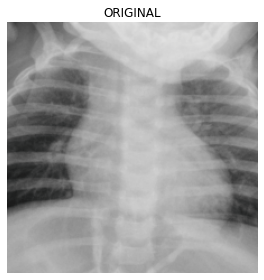
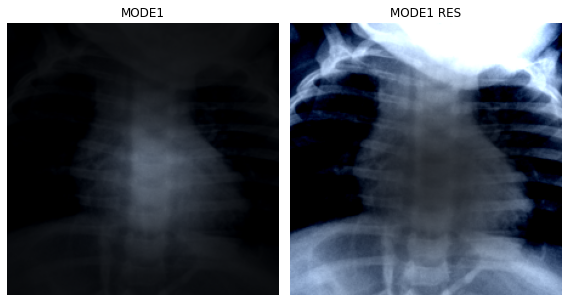
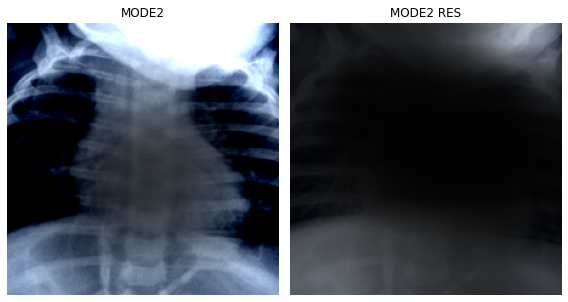
x3=x3.reshape(1,3,224,224)net1.to('cpu')
net2.to('cpu')Sequential(
(0): AdaptiveAvgPool2d(output_size=1)
(1): Flatten(start_dim=1, end_dim=-1)
(2): Linear(in_features=512, out_features=2, bias=False)
)ver22 = torch.einsum('ij,jkl -> ikl', net2[2].weight, net1(x3).squeeze())cam
fig, (ax1,ax2) = plt.subplots(1,2)
#
x3.squeeze().show(ax=ax1)
ax1.imshow(ver22[0].to("cpu").detach(),alpha=0.5,extent=(0,223,223,0),interpolation='bilinear',cmap='cool')
ax1.set_title("NORMAL PART")
#
x3.squeeze().show(ax=ax2)
ax2.imshow(ver22[1].to("cpu").detach(),alpha=0.5,extent=(0,223,223,0),interpolation='bilinear',cmap='cool')
ax2.set_title("DISEASE PART")
fig.set_figwidth(8)
fig.set_figheight(8)
fig.tight_layout()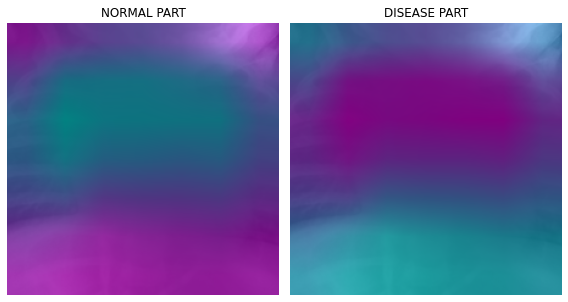
fig, (ax1,ax2, ax3) = plt.subplots(1,3)
#
dls.train.decode((x,))[0].squeeze().show(ax=ax1)
ax1.imshow(camimg[1].to("cpu").detach(),alpha=0.5,extent=(0,223,223,0),interpolation='bilinear',cmap='cool')
ax1.set_title("1ST CAM")
#
dls.train.decode((x,))[0].squeeze().show(ax=ax2)
ax2.imshow(ver2[1].to("cpu").detach(),alpha=0.5,extent=(0,223,223,0),interpolation='bilinear',cmap='cool')
ax2.set_title("2ND CAM")
#
dls.train.decode((x,))[0].squeeze().show(ax=ax3)
ax3.imshow(ver22[1].to("cpu").detach(),alpha=0.5,extent=(0,223,223,0),interpolation='bilinear',cmap='cool')
ax3.set_title("3RD CAM")
#
fig.set_figwidth(12)
fig.set_figheight(12)
fig.tight_layout()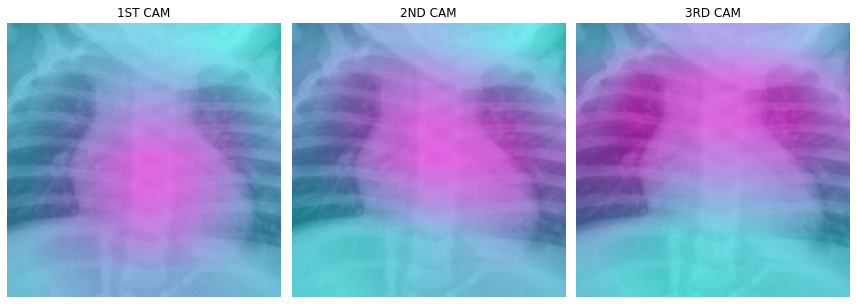
a2=net(x3).tolist()[0][0]
b2=net(x3).tolist()[0][1]
np.exp(a2)/(np.exp(a2)+np.exp(b2)), np.exp(b2)/(np.exp(a2)+np.exp(b2))(4.3886825515670436e-18, 1.0)